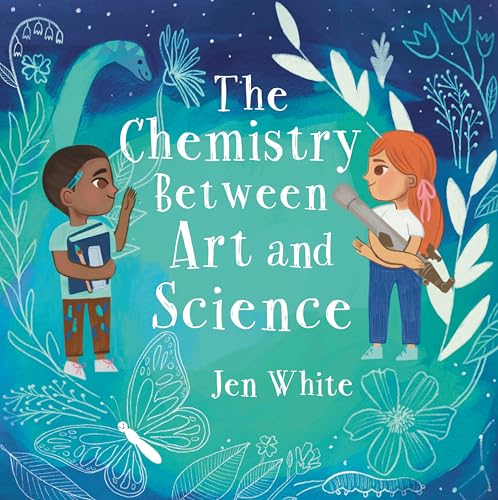The Chemistry Between Art and Science - Jen White - ★★★

AUTHOR: Jen White
GENRE: Children's Nonfiction
PUBLICATION DATE: October 21, 2025
RATING: 3 stars.
In a Nutshell: A picture book about the connection between art and science and how the two can work in sync. A good concept, but I wanted more from the execution. This might click slightly better for older kids than the targeted age group.
Art and Science have long been considered distinct fields. However, there is plenty of science in art (think colour combinations, geometric arrangements, spatial utilisation, structural knowledge of materials, and so on) and plenty of art in science (think botanical sketches, chemical bonds, engineering structures, architectural designs, and so on.) The commonality between the two is a fascinating topic, and hence, I was thrilled when I saw the title of this book. Unfortunately, though it gets some things right, it skips some foundational information and aims at a higher level.
The book begins with some generalised statements about how both art and science involve curiosity, imagination and solutions. The first half of the book is too vague. Lines such as “When they work together, art and science can explain the mysteries of the universe” can be perceived erroneously. Not every art is aimed at solving mysteries, nor does it need to.
The content then proceeds to offer details of some professions where the lines between the two streams blurs. Do you see the huge jump here? We are going directly from generic statements about art and science to professionals using both science and art in their jobs! Where is the interim experience?
The book is aimed at children aged 4 to 8 years. Professions such as aerospace engineers and earth observation scientists would be unknown to a vast majority of this age group. As the approach seems to focus on occupations that involve both art and science, a better idea would have been to write the book in slightly greater detail and pitch it to middle-graders or older kids.
For the actual target age group, a more accessible approach would have been to show the overlap between art and science in their own lives, i.e. in the activities they do or watch others doing. Simple tasks such as cooking, stitching, watching TV, dancing, drawing, and making a Lego structure, all involve art as well as science, and these are activities that 4-8 year olds are more familiar with. Including these things would have helped younger children understand how the supposed demarcation between the two fields is only imaginary.
Of course, what is included in the book is accurate. Those professions do involve the use of artistic and scientific sensibilities. There are mentions of some actual scientists who used both skills. There is even a fabulous example of how origami helped solve a space telescope issue. (The book includes an activity related to this telescope at the end.) These will be appreciated by older children.
That said, some of the ideas in the book could be slightly misleading, especially given that the book is talking at a ‘professions’ level. For instance, stating that ‘art and science are building bridges for wildlife’ doesn’t clarify that it’s one single field of architecture using both art and science for this. Most of the examples provided in the book are of scientific professions that rely on artistic knowhow. The only time the book highlights artistic professions that involve scientific acumen are in the final section titled ‘When I Grow up, I Want To Be…’, where two of the six professions are ballet dancer and musician. So the portrayal is slightly lopsided.
There is an extensive glossary at the end for all the difficult words – a necessary addition.
The illustrations are great in colour as well as diversity. I love that the little boy on the cover (who also pops up inside the book) is an artist and the young girl is into science. Yay for shattering gender myths.
Overall, this book had tremendous potential, but by focussing mainly on (STEM) professions, it stresses on the distant future of its young readers. I would have appreciated it better had the approach been balanced between art and science, and the focus would have been more on the day-to-day intermingling of the two knowledge areas.
Recommended to ages 7-10, though this isn't the target official age group.
My thanks to Holiday House for providing the DRC of “The Chemistry Between Art and Science” via Edelweiss+. This review is voluntary and contains my honest opinion about the book.


Comments
Post a Comment